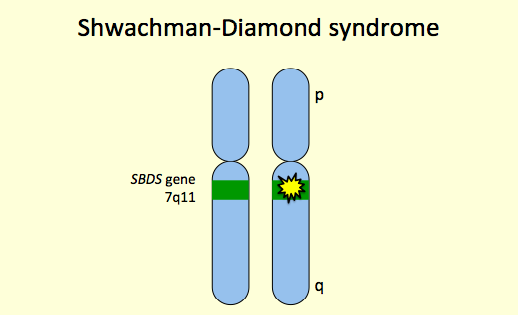Shwachman-Diamond Syndrome (SDS) causes, symptoms, treatment, life expectancy, prognosis and the survival rates. Shwachman–Diamond syndrome is a rare genetic disease characterized by exocrine pancreatic insufficiency, bone marrow dysfunction, skeletal abnormalities, and short stature.
Shwachman-Diamond Syndrome is the second most common cause of inherited pancreatic insufficiency after Cystic Fibrosis and the third most common inherited Bone Marrow Failure syndrome after Fanconi Anemia and Blackfan-Diamond Anemia.
It is also called Shwachman–Bodian–Diamond Syndrome (SBDS). Because this genetic disorder was first reported in 1964 by a joint research of Dr. Harry Shwachman (an American physician), Dr. Martin Bodian (a British ophthalmologist) and Dr. Louis Klein Diamond (an American pediatrician). They were working with a group of five children participating in a Cystic Fibrosis (CF) clinic at Harvard Medical School.
Shwachman-Diamond disease can vary greatly from child to child but affects several body systems, including the bone marrow, pancreas, and skeleton (and occasionally the liver and teeth). It can vary greatly from child to child but affects several body systems, including the bone marrow, pancreas, and skeleton (and occasionally the liver and teeth).
Shwachman Syndrome is always an autosomal recessive genetic condition. This means that parents of an affected child have a 25% risk that any subsequent child will also be affected. There is an unexplained excess of affected males. In addition, Dana-Farber/Boston Children’s physician-scientists are investigating the role of molecules called microRNAs (which can control how genes are expressed) in SDS. Dana-Farber/Boston Children’s is a leading member of the SDS registry.
SDS/SBDS – Shwachman-Diamond Syndrome
Shwachman-Diamond syndrome has many other names including Congenital Lipomatosis of Pancreas, Metaphyseal chondrodysplasia, Shwachman type SDS, Shwachman-Bodian-Diamond syndrome, Shwachman-Bodian syndrome, Shwachman-Diamond-Oski Syndrome, Shwachman syndrome. But basically these all refer to a rare congenital disorder.
It is an inherited condition that affects many parts of the body. It effects blood, bone marrow, and pancreas and involves malfunctioning of other organs such as liver and teeth. Let’s look at its symptoms, causes, and treatment in details:
Shwachman-Diamond Syndrome Symptoms
Since the original description of SDS, Shwachman-Diamond Syndrome Symptoms include a wide variety of abnormalities and involving multiple organs. These include dental abnormalities, dermatological conditions such as severe eczema and ichthyoids, facial abnormalities, myocardial fibrosis, renal calculi and renal tract abnormalities.
SDS patients may have isolated cytopenias other than neutropenia, including anemia and thrombocytopenia, and a significant proportion of them develops aplastic anemia. Other SDS symptoms and abnormalities includes:
- Hematologic Abnormalities e.g. Anemia (low red blood cell count) and Thrombocytopenia (low platelet count) may occur. Patients may develop progressive bone marrow failure or transform to acute myelogenous leukemia.
- Exocrine Pancreatic Dysfunction or lack of acinar cells, extensively depleted and replaced by fat.
- Growth retardation
- Increased frequency of infections
- Hepatic dysfunction
- Metaphysical dysostosis
- Problem with feeding
- Greasy and fowl smelling diarrhea
- Low levels of vitamins (A, D, E and K)
Shwachman-Diamond Syndrome Causes
SDS is basically caused by gene mutation and in 90% cases, it is a compound heterozygous mutation in the 7th chromosome. This gene was identified in 2002 and is thought to encode a protein of 250 amino acids. Shwachman-Diamond Syndrome causes are inherited autosomal recessive traits that result in Exocrine pancreatic insufficiency and Bone marrow dysfunction. Following underlying syndromes are also related to cause Shwachman-Diamond syndrome:
- Pearson-Marrow-Pancreas Syndrome
- Kostmann’s Syndrome: Genetic infantile agranulocystosis
- Johanson-Blizzard Syndrome: Malabsorbtion of fats and nutrients
- Metaphyseal Chondrodysplasia: (McKusick type) short limbed dwarfism

Shwachman-Diamond Syndrome Treatment
Patients with Shwachman-Diamond syndrome usually require care from specialists in hematology, gastroenterology, endocrinology and orthopedics. With modern treatment options and ongoing management, most children with Shwachman-Diamond syndrome lead normal lives, although continued medications and regular monitoring through hospital visits are usually required. These are typically annual visits for children without any major problems or more frequently for those with complications.
Shwachman-Diamond syndrome treatment depends on the kinds of problems associated with it. Bone marrow failure treatment is cured by hematopoietic cell transplantation (also called bone marrow transplant or stem cell transplant). For Short Stature treatment, children are referred to an endocrinologist. Shwachman-Diamond syndrome medicines used for treatment includes:
- Pancreatic Enzymes: for digestion pancreatic enzyme supplements are included to diet.
- Growth Factor Therapy: Growth stimulator G-CSF is prescribed which helps in growth.
- Antibiotics: Prophylaxis may be used to cure infections.
- Surgery may be used for skeletal abnormalities.
- Low serum pancreatic trypsinogen and low isoamylase are useful in patients.
Shwachman-Diamond Syndrome Life Expectancy
Shwachman-Diamond Syndrome life expectancy is approximately 35 years. However, the patients with significant hematological abnormalities including AML have significant morbidity and mortality and have subsequently reduced life. Calculated mean survival of the patients with Shwachman-Diamond Syndrome is 35 years of age. However, many patients who suffer from aplastic anemia, MDS or leukemia their life expectancy is 18 years of age. The age-dependent cumulative probability of leukemia is greater than 70%.
United Nation Library of Medicine resources with help from MedlinePlus offer information about the diagnosis and management SDS. This includes Diagnostic Tests, Drug Therapy, Surgery, Rehabilitation, Genetic Counseling and Palliative Care.
Shwachman-Diamond Syndrome Foundation
Shwachman-Diamond Syndrome Foundation (SDSF) is a support organization helping the victims of this disease. It provides a network for families to receive information, advocacy, emotional support, and keep them updated about the research and development on the cure of this disease.
 Health & Care Information
Health & Care Information



